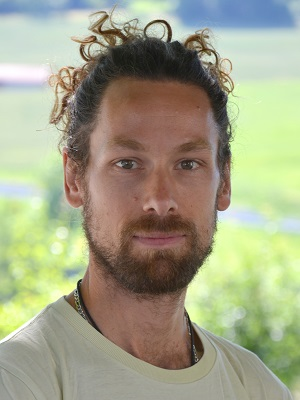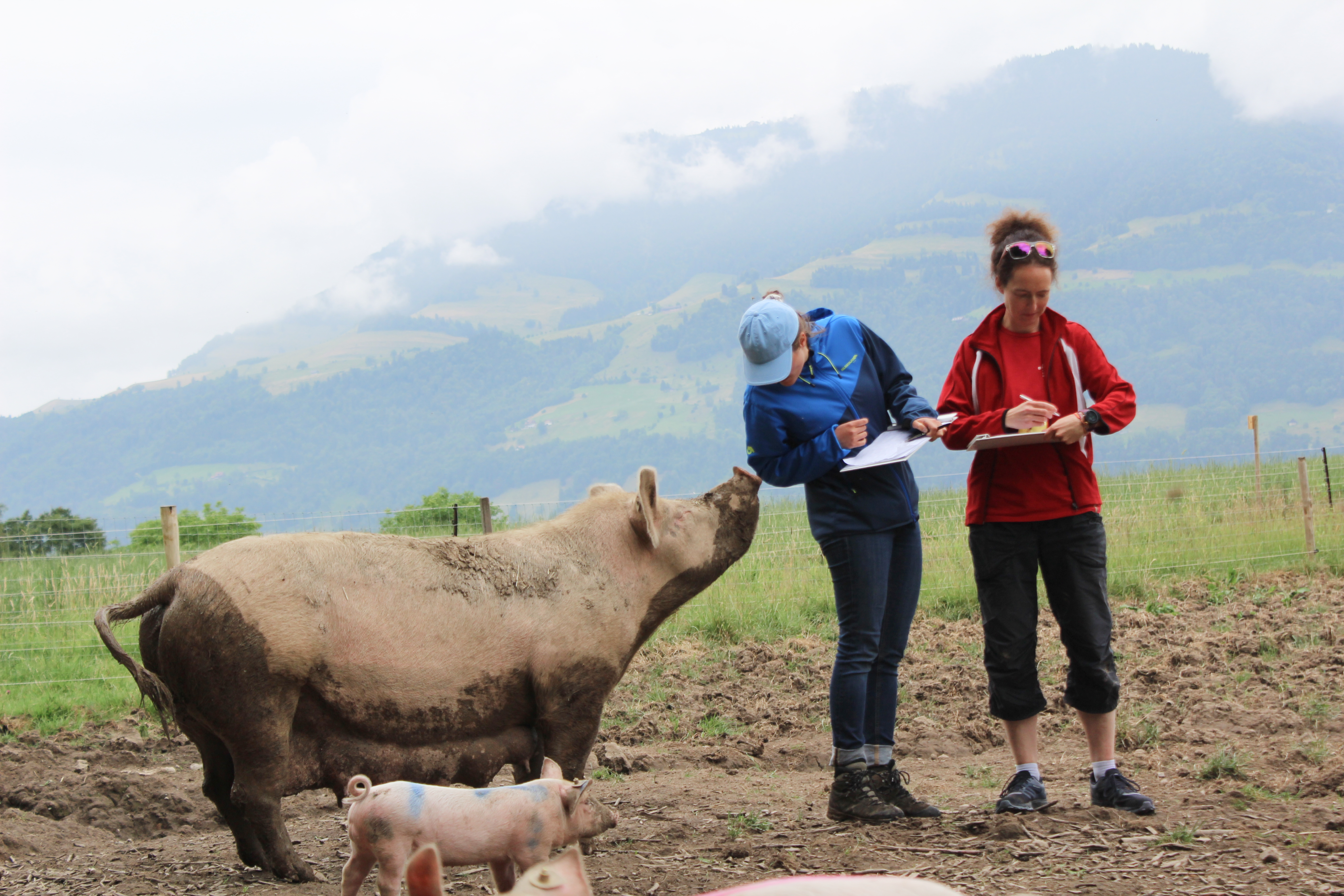A look behind the scenes of the "SchweinErleben" project
A group of three sows and their piglets is being observed over a period of three years to gain insights into the natural behavior of pigs. Cameras capture how the pigs sleep, suckle, forage for food in the forest, play, fight, or wallow in the mud. With the support of hundreds of volunteers, Dr Mirjam Holinger and Dr Maxime Garcia are now sifting through the many hours of footage. This is the SchweinErleben project.
Today, the two researchers offer us a look behind the scenes: who they are, what drives them, and what they aim to achieve with their research project.
Author: Alessandro Rearte
The interview was conducted in writing.
Alessandro Rearte: Mirjam and Maxime, apart from a few dozen pigs, you are the main characters in this project. Can you each tell us what your contributions to the projects are? It would also be interesting to hear about what a typical working day of yours at the office, the lab or in the field looks – if there’s any such thing like a typical day!
Mirjam is a researcher on the SchweinErleben project and serves as the main coordinator for the different phases, encompassing both research and outreach. She is joined by Maxime, who is responsible for animal behavior data collection and the implementation of the citizen science component of the project. These tasks involve observing the pigs' behavior on-site and through video recordings, as well as engaging the public in data collection via an online platform. Together, we are responsible for designing protocols that facilitate data collection on the various questions raised within the project.
Typical working days are... not so typical! On days spent at the office, our tasks can range from brainstorming data collection protocols to programming AI codes for extracting video sequences based on automatic pig identification. We also reach out to various collaborators to assist in recruiting citizen scientists, communicate with the team at Panoramahof (the farm hosting the project) about specific on-site requirements, coordinate schedules between film crews, public visits, and on-site research, and enter field data into various computer programs.
In contrast, field days are more standardized, comprising four blocks of two hours of continuous observations, during which the observer conducts group scans every 10 minutes. The time spent between observation blocks is occupied with backing up video recordings, opportunistic pig behavior observations (that is, when there is something special to be observed outside of standardized observation blocks), and ensuring all necessary data is captured (such as individual ID numbers and cleaning camera lenses). Although field days are highly structured, they are always different, depending on what the pigs have on their agenda!
SchweinErleben wants to find out how domestic pigs behave in a natural environment including forests, pastures and wallows. Are there any specific outcomes you hope to achieve? Any burning questions you hope to answer?
The project is relatively broad and aims to capture how pigs behave when placed in an environment that allows them to express their full potential. While the approach is exploratory and open to any conclusion, the ultimate goal is to identify keys to improving animal welfare for farmed animals, without necessarily intending to overhaul farming practices. Rather than a study that could impose limitations on current farming methods, we want the project to be seen as a tool for farmers interested in higher welfare standards for their animals.
Some of the key questions we tackle in SchweinErleben are:
- Whether entire males (i.e., non-castrated males) pose a problem when kept in groups, and if so, how negative behavior can be managed.
- Whether rooting/foraging behavior is primarily linked to feeding or if it has a well-being dimension.
What else motivated you to conduct this research?
Of course, the possibility of bringing changes that would benefit both farmers and their animals is a main tenet of the project. Yet, another equally important aspect lies in raising public awareness about the true nature of pigs. The common perception of pigs is generally very limited and often reinforced by language that associates pigs with dirtiness (e.g., "eating like a pig", "being dirty like a pig"). By studying and showcasing the complexity and richness of pigs' natural behavior (such as mother-offspring relationships, use of functional areas, and cognitive abilities), we hope to foster a better appreciation of this species among meat consumers and animal enthusiasts.
Tell us about your idea to set up a participatory research project. How do you and the participants benefit from it?
The idea was to create a platform where the general public could learn more about domestic pigs' behavior while helping us with data collection. Since we gathered enormous amounts of video data, analyzing it all on our own would have required an impractical amount of time. Involving citizen scientists in the analysis of this data was a fantastic way to achieve another goal of our project: raising awareness and knowledge about domestic pigs!
For the participatory part of the research, the analysis of countless hours of video footage, you chose our ProjectBuilder. Tell us about your experience so far.
The ProjectBuilder allows for a wide range of approaches, from presenting images to video clips, and from answering multiple-choice questionnaires to open-ended questions, with or without dependencies. In summary, the platform offers great flexibility! Daniel, the project developer, was instrumental in helping us navigate through the ProjectBuilder. His assistance and technical advice enabled us to fine-tune the interface to meet our needs. It is important to keep in mind that the ProjectBuilder works with prepared data. It does not allow you to manipulate your original data (e.g., using images or video clips requires you to have these files readily available for upload to the ProjectBuilder; you cannot cut, extract, or modify image or video files from within the platform). This is entirely normal, as the ProjectBuilder is not designed for data manipulation, but it is an important point for non-specialists to remember.
Any recommendations for researchers who seek to set up a citizen science project of their own?
Questions should be well-defined before diving into the logistical aspects and implementation of the project. Additionally, it is important to make the project as attractive as possible. We learned that, although pig behavior is interesting, we should have included more add-ons to engage participants further, such as elements of gamification. Consulting existing citizen science projects is a valuable way to refine ideas for your own project. Last but not least, surrounding yourself with a competent team to help with brainstorming, advertising, and programming is the most essential part!
Thank you very much for the interview.
.jpg)
About Dr Maxime Garcia: Maxime is a senior scientist in the group Animal Housing & Livestock Breeding at the Department of Livestock Sciences at FiBL. His research interest mainly lies in the study of social and communication aspects of animal behavior, in order to better understand what environments/contexts contribute to high animal welfare. His work focuses on the study of domestic pigs’ natural behavioral repertoire and on the study of human-animal interactions.
.jpg)
About Dr Mirjam Holinger: Mirjam is a researcher in the area of pig welfare and statistician in the Department of Livestock Sciences at FiBL – the Research Institutes of Organic Agriculture. Her current research work focuses on organic pork production and pig welfare. She is interested in how to improve pig welfare by providing them with additional resources such as roughages, rooting material or showers.


